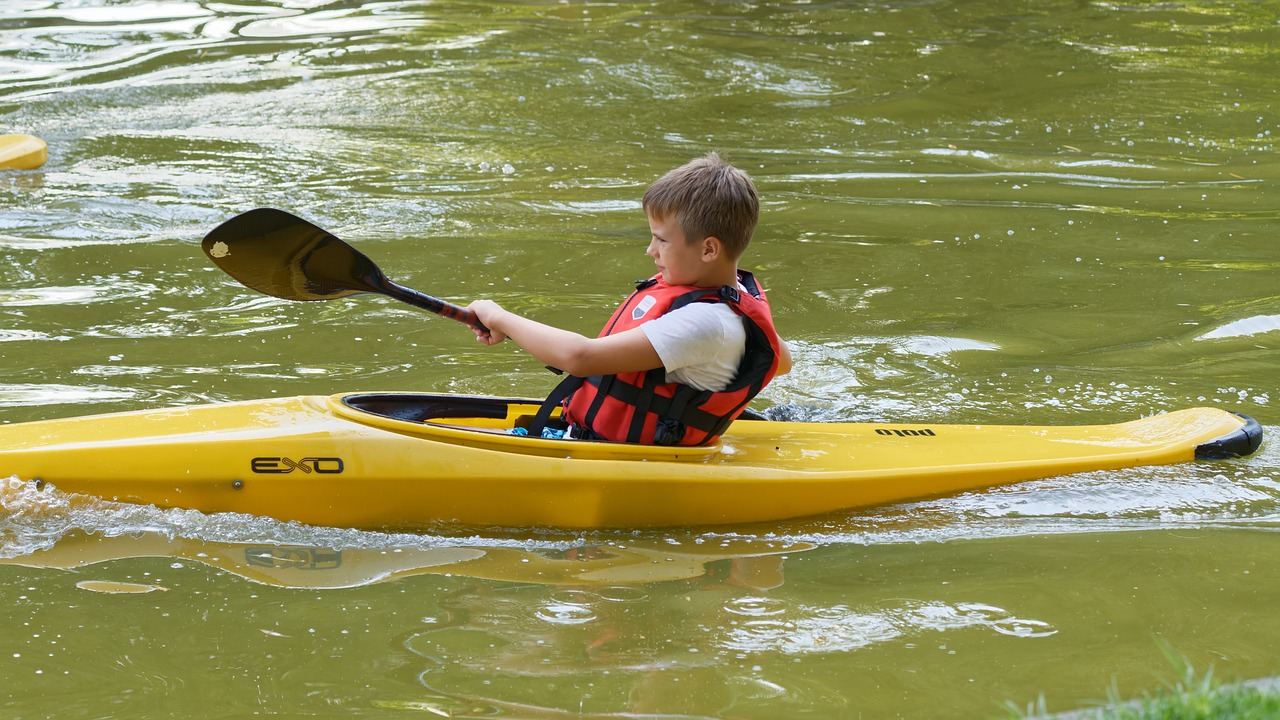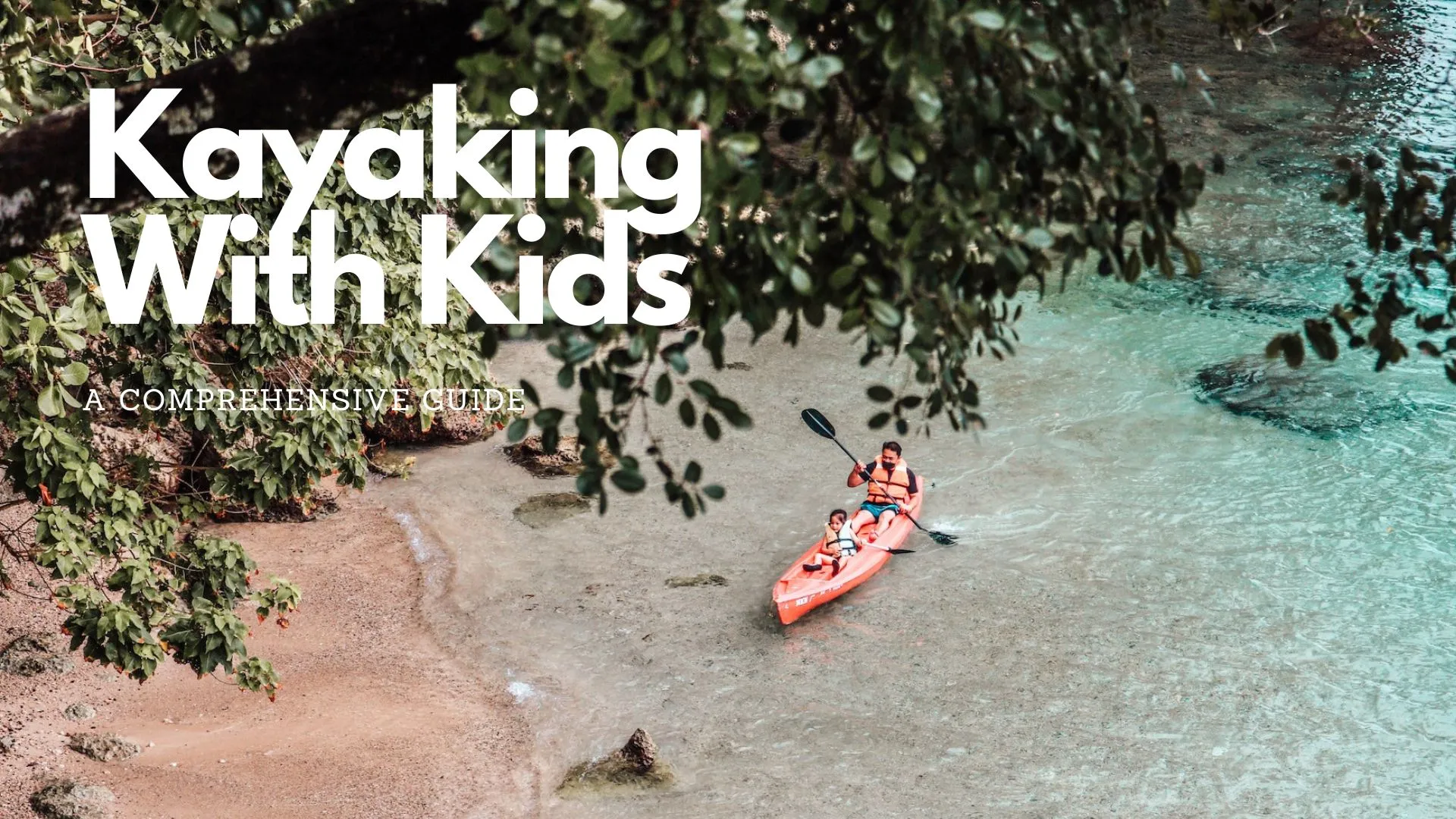Last Updated on March 23, 2023 by Afsar
Kayaking is a fantastic outdoor activity that offers families the opportunity to bond, have fun, and explore the wonders of nature together. With the gentle sound of water lapping against the hull and the rhythmic motion of paddling, kayaking provides an ideal environment for family members of all ages to unwind and connect. Not only does kayaking encourage physical fitness and appreciation for the natural world, but it also fosters teamwork and communication as everyone works together to navigate the waterways.
However, when kayaking with kids, it’s essential to prioritize their safety and enjoyment. Careful planning and preparation are crucial to ensure that your family’s kayaking adventure is not only exciting but also a positive learning experience for the little ones. This article will guide you through essential tips and considerations for kayaking with kids, from selecting the right equipment and teaching basic skills to choosing a suitable location and making the most of your time on the water.
Choosing the Right Equipment
Selecting the appropriate equipment is a vital aspect of ensuring a safe and enjoyable kayaking experience for the whole family. From choosing the right kid kayak and paddle size to understanding the importance of personal flotation devices, this section will guide you through the essential considerations when gearing up for a family kayaking adventure. With the proper equipment in hand, you and your kids will be well-prepared to embark on a memorable journey on the water.
A. Selecting the Appropriate Kayak
Tandem Kayaks: Tandem kayaks are an excellent option for kayaking with kids, as they allow you to paddle together in a single boat. These kayaks typically have two or three seats, with the more experienced paddler (usually the adult) in the rear and the child in the front. Tandem kayaks provide a sense of security and enable parents to keep a close eye on their children while still allowing them to participate in the paddling process.
Sit-on-top Kayaks: Sit-on-top kayaks are another suitable option for families, particularly for beginners and those with younger children. These kayaks have an open, user-friendly design that makes them stable and easy to maneuver. Additionally, sit-on-top kayaks often have self-draining scupper holes, which means that water that enters the kayak will drain out, keeping everyone drier and more comfortable.
B. Ensuring Correct Paddle Size
Selecting the appropriate paddle size is crucial for a comfortable and efficient kayaking experience. When choosing a paddle for your child, consider their height, arm length, and the width of the kayak. A shorter paddle is generally better for children, as it allows them to maintain a proper paddling technique without straining their shoulders or arms. Many paddle manufacturers offer junior-sized paddles, specifically designed for younger kayakers.
C. Importance of Personal Flotation Devices (PFDs)
Proper Fit and Comfort: Personal flotation devices (PFDs) are essential safety gear for all kayakers, regardless of age or skill level. When choosing a PFD for your child, make sure it fits snugly without being too tight, and that it won’t ride up over their face when in the water. Allow your child to try on several PFDs to ensure they find one that is comfortable and doesn’t restrict their movement.
Child-specific PFDs: Look for child-specific PFDs that have features such as a grab handle, which allows for easy retrieval from the water, and a crotch strap, which prevents the PFD from riding up. These PFDs are also designed with additional buoyancy to keep your child’s head above water. Remember to check the weight range specified by the manufacturer to ensure the PFD is appropriate for your child’s size.
A. Teaching Kids Basic Kayaking Skills
Paddling Techniques
Before embarking on your kayaking adventure, take some time to teach your children the fundamentals of paddling. Demonstrate proper paddling techniques, such as holding the paddle with both hands, using torso rotation to generate power, and maintaining a relaxed grip. Encourage your child to practice these techniques on dry land first and then progress to practicing in calm, shallow water.
How to Enter and Exit the Kayak
Teach your child the correct way to enter and exit the kayak to ensure their safety and minimize the risk of capsizing. Start by demonstrating the process yourself, emphasizing the importance of maintaining balance and holding onto the kayak while getting in and out. Practice these steps with your child in shallow water, providing support and guidance as needed.
Familiarizing Kids with Water Safety
Swimming Skills: Before kayaking with your child, make sure they have basic swimming skills and are comfortable in the water. Encourage them to wear a PFD at all times and remind them that it will help keep them afloat if they accidentally end up in the water.
What to Do in Case of a Capsize: Although rare, capsizing is a possibility while kayaking. Teach your child how to remain calm and focused in case of a capsize. Explain the importance of holding onto the kayak, as it can serve as a flotation device, and show them how to re-enter the kayak with assistance. Practicing capsize drills in a controlled environment can help build confidence and prepare your child for unexpected situations.
Packing Essentials
Sun Protection: Spending hours out on the water can lead to sunburn, even on cloudy days. Pack sunscreen with a high SPF, hats, and sunglasses for all family members. Consider using sun-protective clothing, such as long-sleeved rash guards, to provide additional protection from the sun’s harmful rays.
Snacks and Hydration: Bring plenty of water and snacks to keep everyone hydrated and energized throughout the trip. Choose non-perishable, easy-to-eat options like granola bars, trail mix, and fruit. A well-fed and hydrated child is more likely to enjoy the experience and have the energy to participate fully.
Dry Clothing and Towels: Pack dry clothes and towels in a waterproof dry bag so that everyone can change into warm, dry clothing after the kayaking adventure. This will help prevent chills and discomfort, especially on cooler days or after an unexpected swim. Additionally, having dry clothes to change into can make the drive home more comfortable for everyone
Choosing the Right Kayaking Location
Factors to Consider
Calm Waters
When kayaking with kids, it’s essential to choose a location with calm waters. Calm water conditions, such as lakes, ponds, and gentle rivers, provide a safer and more enjoyable environment for beginner kayakers and young children. Avoid areas with strong currents, large waves, or other potentially challenging conditions.
Shallow Areas
Shallow water areas provide an added layer of safety for children, as they allow for easier entry and exit from the kayak and minimize the risk of injury in case of a capsize. If possible, choose a location with a gradual shoreline or designated swimming area where children can stand and practice their skills in the water.
Nearby Facilities (Restrooms, Picnic Areas)
Consider choosing a location with nearby facilities, such as restrooms and picnic areas, for added convenience and comfort. Having access to restrooms is particularly important when kayaking with young children, who may need frequent bathroom breaks. Picnic areas provide an excellent spot for taking breaks, enjoying a meal, and allowing children to stretch their legs and play.
B. Researching Local Kayaking Spots
Online Resources
There are numerous online resources to help you find family-friendly kayaking locations. Websites, blogs, and social media groups dedicated to kayaking often provide helpful information about local waterways, including details about water conditions, accessibility, and nearby facilities. Additionally, local parks and recreation departments often have information about suitable kayaking spots on their websites.
Recommendations from Experienced Kayakers
Seek advice from experienced kayakers in your community, either through local clubs or online forums. These individuals can offer valuable insights into the best kayaking spots for families, as well as provide tips on what to expect and how to prepare. Don’t hesitate to ask questions, as most experienced kayakers are happy to share their knowledge and help others enjoy the sport safely.

On-the-Water Tips
Maintaining Communication and Supervision
While kayaking with kids, it’s crucial to maintain open communication and constant supervision. Establish clear hand signals or vocal cues for essential actions, such as stopping, turning, or slowing down. Ensure that everyone understands and can execute these signals. Keep an eye on your children throughout the trip and make sure they are within earshot and visual range.
Encouraging Teamwork and Cooperation
Kayaking is an excellent opportunity to foster teamwork and cooperation among family members. Encourage your child to work together with you and other family members in paddling and navigating the water. Praise their efforts and offer constructive feedback to help them improve their skills. Reinforce the idea that kayaking is a shared experience, and everyone’s contributions are essential to the success of the adventure.
Making the Experience Enjoyable
Incorporating Games and Activities: To keep children engaged and entertained while kayaking, consider incorporating games and activities into the trip. Simple games like “I Spy” or “Follow the Leader” can help maintain interest and make the experience more fun. You can also create challenges, such as racing to a specific point or collecting floating debris (e.g., leaves or small sticks) as an environmental cleanup activity.
Observing Wildlife and Nature: One of the joys of kayaking is the opportunity to observe wildlife and nature up close. Teach your child to appreciate the beauty and diversity of their surroundings by pointing out interesting plants, animals, or natural features. Encourage them to observe quietly and respectfully, explaining the importance of not disturbing the wildlife.
Taking Breaks and Exploring the Surroundings: Allow time for regular breaks during your kayaking adventure to let your child rest and explore the surroundings. This can be an excellent opportunity to stretch your legs, enjoy a snack, or investigate a nearby shoreline or island. Encourage your child to explore and engage with their environment, as it can foster a sense of curiosity and appreciation for nature.
Post-Kayaking Considerations with Your Kids
Cleaning and Storing Equipment
After a fun day of kayaking, it’s essential to clean and store your equipment properly to ensure its longevity and good condition. Teach your child the importance of caring for their gear by involving them in the process. Rinse off the kayak, paddles, and PFDs with fresh water to remove any dirt, sand, or debris. Allow all equipment to dry thoroughly before storing it in a cool, dry place, away from direct sunlight. Encouraging your child to participate in this process will help them develop a sense of responsibility and appreciation for their equipment.
Discussing the Experience with Your Kids
Reflecting on Lessons Learned: Once the adventure is over, take some time to discuss the experience with your child. Ask them what they enjoyed most about the trip, and if there were any challenges they faced. Reflect on any lessons learned, such as improving paddling techniques or overcoming fears. This conversation can help your child process their experience, recognize their achievements, and build confidence for future kayaking adventures.
Planning Future Kayaking Adventures: As you discuss the day’s events, encourage your child to think about what they’d like to try on future kayaking trips. Perhaps they’d like to explore new locations, try different types of kayaks, or learn more advanced paddling skills. Brainstorm ideas together and make a list of potential destinations or goals for your next family kayaking adventure. Involving your child in the planning process can help build excitement and anticipation for future outings, as well as strengthen the bond between you and your child through shared experiences.
kayaking is a wonderful family activity that allows you to connect with nature, bond with your loved ones, and create lasting memories. To ensure a safe and enjoyable experience for everyone, especially when kayaking with kids, careful preparation is crucial. By selecting the right equipment, teaching essential skills, familiarizing kids with water safety, and choosing appropriate locations, you lay the foundation for a successful kayaking adventure. Always prioritize safety and open communication, and remember to make the experience enjoyable by incorporating games, observing nature, and taking breaks to explore your surroundings. By involving your child in the entire process, from planning to post-adventure reflections, you’ll foster a love for kayaking and the outdoors that can last a lifetime. So gather your family, grab your paddles, and embark on a thrilling kayaking adventure together.
Videos about Kayaking with Kids

Afsar is an avid kayak blogger born near the coast. He has a passion for kayaking and started as a child. He has paddled in various conditions and locations and promotes responsible kayaking. Afsar’s blog is widely read, and they are a respected voice in the kayaking community, offering valuable content on kayaking trips, gear, tips, and tricks. Afsar collaborates with other bloggers and brands and continues to inspire others through their writing and social media.

